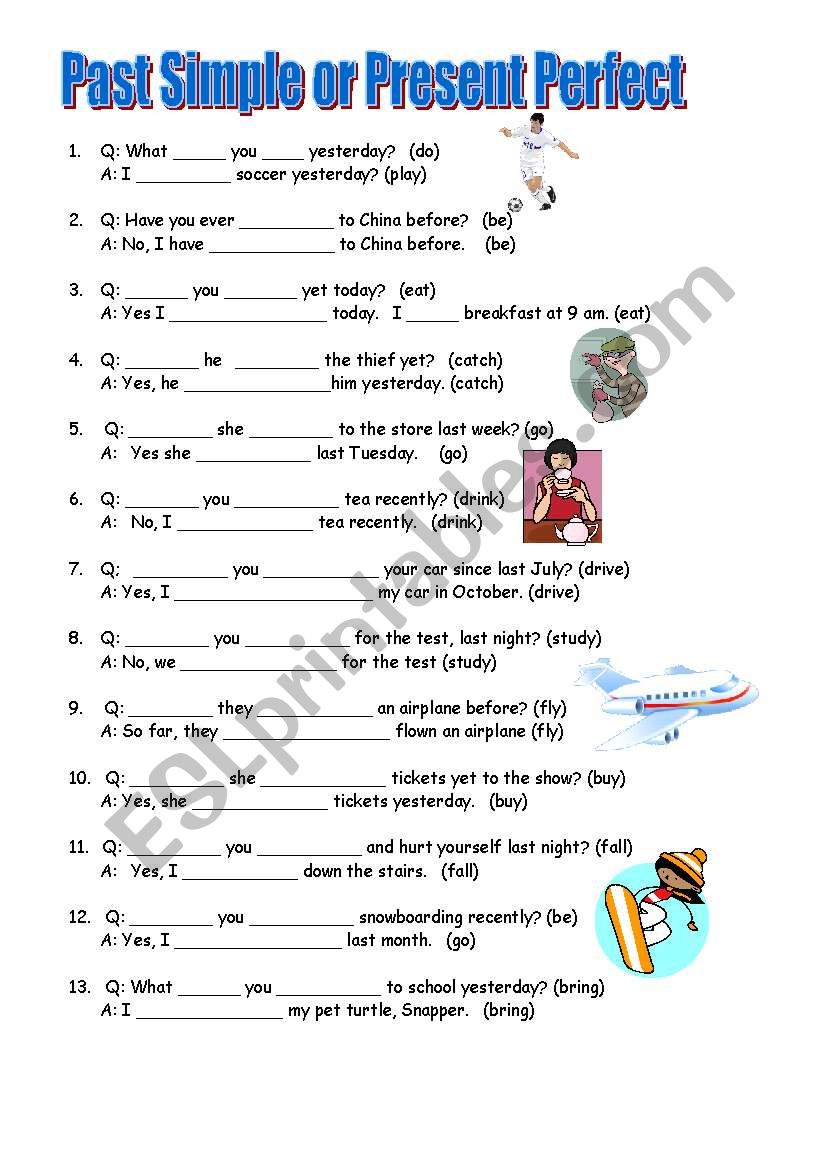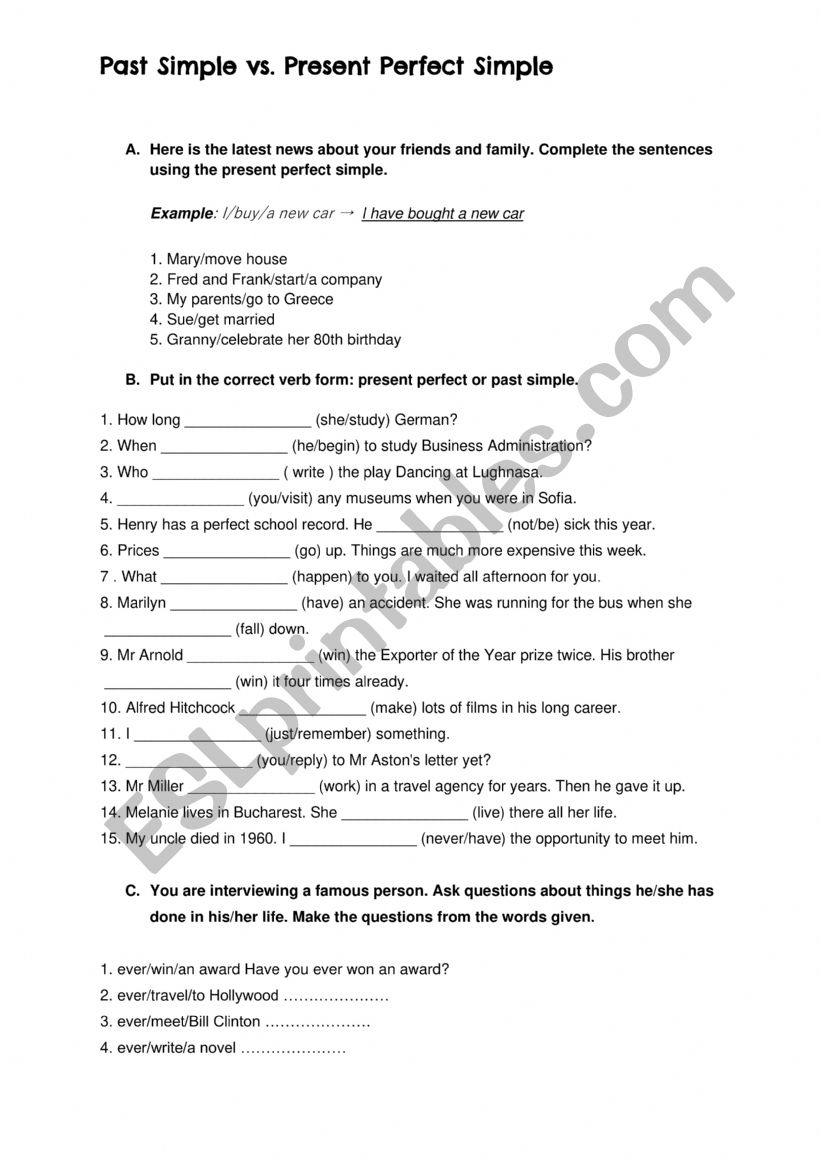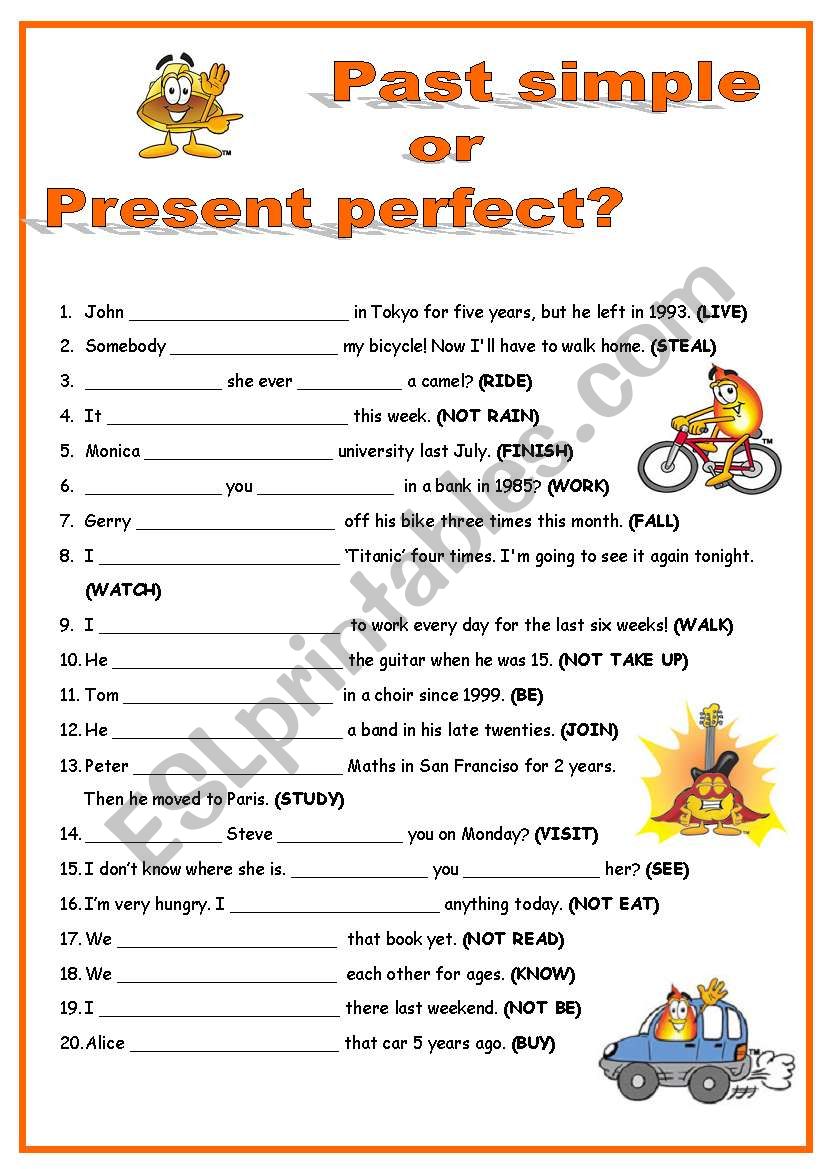
Unlocking Fluency: A Comprehensive Guide to Mastering Present Perfect vs Past Simple Worksheets B1
Few grammatical distinctions in English cause as much confusion and frustration for intermediate learners as the nuanced differences between the Present Perfect and the Past Simple tenses. While seemingly straightforward, their application often trips up even diligent students, leading to errors that can significantly impact clarity and meaning. For B1 level learners, grasping these concepts is not just about grammatical correctness; it’s a critical step towards achieving true fluency and expressing complex ideas accurately. This comprehensive guide will delve deep into the mechanics of both tenses, illuminate their core differences, and critically examine the indispensable role of effective Present perfect vs past simple worksheets B1 in solidifying understanding and building confidence.
The Past Simple: A Look Back at Finished Actions
Let’s begin with the Past Simple, often the first past tense introduced to English learners. It describes actions, events, or states that were completed at a specific point in the past. There is no connection to the present moment.

Form:

- Regular Verbs: Base form + -ed (e.g., walked, played, started)
- Irregular Verbs: Unique forms that must be memorized (e.g., went, saw, ate, had)



Key Uses:
-
Completed Actions at a Specific Time in the Past: This is the most common use. The time can be explicitly stated or clearly understood from the context.

- Examples:

- She visited Paris last year.
- I finished my homework an hour ago.
- They watched a movie yesterday evening.


- Examples:
-
Series of Completed Actions in the Past: Used to describe events that happened one after another.
- Examples:
- He woke up, ate breakfast, and then left for work.
- First, she opened the book, then she started reading.
- Examples:
-
Past Habits or Routines (often with ‘used to’ or frequency adverbs): When talking about things that happened regularly in the past but don’t happen anymore.
- Examples:
- When I was a child, I played outside every day.
- We lived in London for five years. (implies we don’t live there now)
- Examples:
Common Time Expressions:
- Yesterday, last week/month/year, an hour/day/week ago, in 2010, on Monday, when I was young, during the holidays.
The Past Simple acts like a closed chapter in a book – the story is over, and the time of the event is clear.
The Present Perfect: Bridging Past and Present
In contrast to the definitive nature of the Past Simple, the Present Perfect is a fascinating tense that truly connects the past to the present. It describes actions or states that happened at an unspecified time in the past, or actions that started in the past and continue into the present, or actions that happened in the past but have a result that is relevant now.
Form:
- Have/Has + Past Participle (Verb 3)
- Examples:
- I have seen that movie.
- She has lived here for five years.
- They have finished their project.
- Examples:
Key Uses:
-
Actions that Happened at an Unspecified Time in the Past: The exact time is not important or not known. The focus is on the experience or the fact that the action occurred.
- Examples:
- I have visited Rome. (The exact time of the visit isn’t specified, just the experience.)
- He has read that book. (It doesn’t matter when, just that he’s read it.)
- Examples:
-
Experiences: Often used to talk about things you have (or haven’t) done in your life up to the present moment.
- Examples:
- Have you ever been to New York?
- I have never eaten sushi.
- Examples:
-
Actions that Started in the Past and Continue to the Present: This is particularly common with verbs like live, work, study, be.
- Examples:
- She has lived in this city since 2010. (She started living here in 2010 and still lives here.)
- We have known each other for ten years. (We met ten years ago and still know each other.)
- Examples:
-
Actions Completed Recently with a Present Result: The action happened in the recent past, and its consequence or effect is still felt or relevant now.
- Examples:
- I have lost my keys. (The action of losing is past, but the result – I don’t have them now – is present.)
- He has broken his leg. (The breaking happened, but his leg is still broken.)
- They have just arrived. (They arrived a moment ago, and their presence is current.)
- Examples:
Common Time Expressions:
- Ever, never, just, already, yet (in questions/negatives), for (duration), since (point in time), recently, lately, so far, today/this week/this month/this year (if the period is not finished).
The Present Perfect is like an open chapter – the story might have started in the past, but it’s still ongoing or has a direct impact on the present.
The Core Confusion: Present Perfect vs Past Simple – Direct Comparison
The primary source of confusion between these two tenses for B1 learners lies in understanding when an action is truly "finished" with no connection to the present, versus when it has a lingering effect or an unspecified timeframe that connects it to "now."
Let’s look at direct comparisons:
| Feature | Past Simple | Present Perfect |
|---|---|---|
| Focus | When an action happened (specific past time) | What has happened (result/experience up to now) |
| Timeframe | Finished time period | Unfinished time period, or time is not important |
| Connection to Now | None | Strong connection to the present |
| Common Adverbs | Yesterday, last week, in 2005, an hour ago | Just, already, yet, ever, never, for, since, recently |
| Example 1 | I went to the cinema last night. | I have been to the cinema many times. |
| Example 2 | She ate breakfast at 8 AM. | She has eaten breakfast already. |
| Example 3 | He lived in Paris from 2000 to 2005. | He has lived in Paris since 2005. |
| Example 4 | I finished my project yesterday. | I have finished my project. (Result: it’s done now) |
Key Takeaway for B1 Learners:
- If you mention or imply a specific finished time in the past (e.g., yesterday, last year, in 1999, when I was 5), you almost always use the Past Simple.
- If the time is unspecified, or the action continues to the present, or its result is relevant now, use the Present Perfect.
A common pitfall is using Present Perfect with specific past time expressions (e.g., "I have gone to the shop yesterday" – incorrect!). Similarly, using Past Simple when the action has a clear connection to the present (e.g., "I lost my keys, so I can’t open the door now" – while grammatically possible, "I have lost my keys" better conveys the present consequence).
Why Worksheets are Crucial for B1 Learners
For B1 learners, targeted Present perfect vs past simple worksheets B1 are not just supplementary material; they are an essential tool for internalizing these complex grammatical rules. At this intermediate level, learners are moving beyond simple memorization and need to apply rules in varied contexts. Worksheets provide:
- Reinforcement: Repeated exposure to the structures and their usage helps solidify understanding.
- Contextual Practice: Good worksheets present sentences within meaningful contexts, helping learners understand when to use each tense, not just how to form it.
- Identification of Weak Spots: As learners complete exercises, they (and their teachers) can identify specific areas of confusion or common errors, allowing for targeted review.
- Variety of Exercise Types: Different exercise formats (gap-fill, multiple choice, sentence transformation, error correction, dialogue completion) engage different cognitive processes and ensure a comprehensive understanding.
- Self-Correction: Worksheets with answer keys empower learners to check their own understanding and learn from their mistakes.
Without structured practice provided by well-designed Present perfect vs past simple worksheets B1, learners might understand the theory but struggle immensely with practical application in speaking and writing.
Designing Effective Present Perfect vs Past Simple Worksheets B1
When designing or selecting Present perfect vs past simple worksheets B1, several pedagogical principles should be considered to maximize their effectiveness:
- Clear Instructions: Instructions must be concise and unambiguous. For B1 learners, using clear, simple English is paramount.
- Contextualized Sentences: Avoid isolated sentences. Present the grammar within mini-dialogues, short paragraphs, or scenarios that reflect real-life situations. This helps learners grasp the meaning and function of the tenses.
- Example: Instead of just "I (eat) breakfast.", use: "A: What did you do this morning? B: I (eat) breakfast, then I (go) to work." Or: "A: you ever (try) sushi? B: Yes, I (try) it last year when I ___ (visit) Japan."
- Gradual Difficulty: Start with simpler, more obvious examples (e.g., clear time expressions) and gradually introduce more nuanced situations where the choice depends more on the intended meaning or connection to the present.
- Focus on Common Errors: Design exercises that specifically target common B1 pitfalls, such as:
- Using Present Perfect with specific past time expressions ("I have seen him yesterday." -> Incorrect)
- Using Past Simple when the action is unfinished or has a present result ("I broke my leg, so I can’t walk." -> Better: "I have broken my leg…")
- Confusion with ‘for’ and ‘since’.
- Variety of Exercise Types:
- Gap-fill: Most common, but ensure sentences are contextual.
- Choose the Correct Tense: Provide both options and ask learners to select and justify.
- Sentence Transformation: Change a Past Simple sentence to Present Perfect (if possible) or vice-versa, emphasizing the change in meaning.
- Error Correction: Provide sentences with errors and ask learners to identify and correct them. This develops critical thinking.
- Dialogue Completion: Students complete dialogues using the appropriate tense.
- Question Formulation: Students form questions (e.g., "Have you ever…?", "When did you…?").
- Relevant B1 Vocabulary: Ensure the vocabulary used in the worksheets is appropriate for the B1 level, avoiding overly complex words that might distract from the grammatical focus.
- Include Answer Keys: Crucial for self-study and for teachers to quickly check understanding. Explain why an answer is correct when necessary.
By meticulously crafting or selecting Present perfect vs past simple worksheets B1 that adhere to these principles, educators can provide learners with the structured practice they need to confidently differentiate and apply these two vital tenses.
Beyond Worksheets: Complementary Learning Strategies
While Present perfect vs past simple worksheets B1 are fundamental, they are most effective when integrated into a broader learning strategy. To truly master these tenses, B1 learners should also:
- Engage with Authentic Materials: Listen to podcasts, watch English TV shows, and read articles or short stories. Pay close attention to how native speakers use these tenses in natural contexts.
- Practice Speaking: Actively try to use both tenses in conversations. Describe past experiences (Present Perfect) and specific past events (Past Simple). Don’t be afraid to make mistakes; correction is part of the learning process.
- Write Regularly: Keep a journal, write short essays, or participate in online forums. Consciously try to apply the rules of both tenses in your writing.
- Utilize Timelines: Drawing timelines can be an excellent visual aid. Mark specific past events (Past Simple) and ongoing actions or experiences that started in the past and continue to the present (Present Perfect).
- Self-Correction and Reflection: After completing a worksheet or a speaking task, take time to review your errors. Understand why you made a mistake and how to correct it.
Conclusion
Mastering the nuances of the Present Perfect and the Past Simple is a significant milestone for B1 English learners. It requires not only a theoretical understanding of their forms and rules but also extensive practical application. Well-designed and strategically utilized Present perfect vs past simple worksheets B1 serve as an invaluable backbone for this learning process, providing the structured, contextualized practice necessary to move from confusion to clarity.
By combining focused worksheet practice with active listening, speaking, and writing, B1 learners can build the confidence and accuracy required to navigate complex English conversations and express themselves with precision. Embrace the challenge, dedicate time to consistent practice, and watch your fluency in these essential tenses blossom. The journey to mastering English grammar, particularly the Present Perfect and Past Simple, is a rewarding one, and effective worksheets are your steadfast companions on this path.
